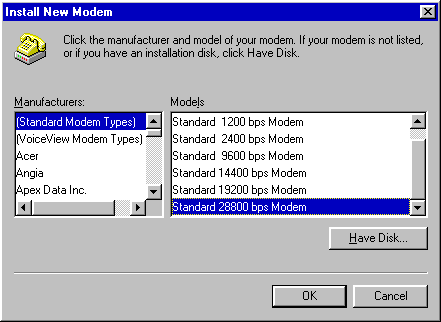|
|||||||||

In Windows 98 or Windows 95
|
 1. Windows 95
and Windows 98 have almost identical configuration routines for modems (with a few
cosmetic differences). If your dealer didn't set your modem up when you purchased your PC,
or if you've bought a modem since buying the PC, you'll need to set the modem up. From the
Start Menu, choose Settings and then Control Panel from the cascading menu that appears. 1. Windows 95
and Windows 98 have almost identical configuration routines for modems (with a few
cosmetic differences). If your dealer didn't set your modem up when you purchased your PC,
or if you've bought a modem since buying the PC, you'll need to set the modem up. From the
Start Menu, choose Settings and then Control Panel from the cascading menu that appears.
|
2. When the Control Panel
opens, double-click the Modems icon. If you don't have a modem installed, the Install New
Modem Wizard will be run. If you already have one installed but you're adding a new one,
double-clicking the Modems icon will open a Modems dialogue box; in that box, click the
Add button to run the Install New Modem Wizard. Windows can auto-detect the modem for you
(in which case it performs a number of standard checks on the modem and then makes an
assumption as to the best setting), or you can choose your own from a list. Click Next to
proceed.
|
3. If you choose your modem
from the list, you'll find an extensive selection including many Australian modems, as
well as some of the internationally recognised brands such as Hayes, Microcom and US
Robotics. Click your modem in the Manufacturers list and then click the specific modem in
the Models list. Then click Next.
|
4. If your modem is not shown
on the list, click the upwards arrow on the right of the Manufacturers list to scroll the
list right up to the top. There you'll see a 'Standard modem' item. Click it and then
select the appropriate speed (probably 28,800bps, 33,600bps or 56,000bps) in the Models
list. You'll be asked to select which port (connector) your modem is on. It will most
likely be COM 1, although it could possibly be COM 2 if your mouse is using the first
serial port. Most new mice use a PS/2 mouse port and leave COM 1 vacant for the modem.
|
5. Now you need to tell
Windows where you'll be calling from (this happens only one time -- if you've already set
up any other communications service, or someone has done it for you, you won't be prompted
for this information). Select Australia from the list of countries and then in the area
code box put your phone area code without the preceding zero.
|
6. The next box is the Modem
Properties dialogue box where you can adjust various settings of your modem. Click the
Properties button to check what the current settings are. Most of these you'll want to
leave alone.
|
7. One setting you might want
to check is the Maximum Speed at the foot of the General tab -- this is the speed of the
serial port on your computer. It controls how fast information is exchanged between the
modem and the computer, and is independent of the modem speed. On most new computers, you
should have high-speed COM ports (called 16550 UARTs -- dreadful, I know, but that's the
sort of jargon you'll find with computers!) which can handle data as fast as your modem
can pump it through. With a high-speed COM port, if you have a 14,400bps modem, set the
port speed to 19,200 or 38,400. If you have a 28,800bps or 33,600bps modem, set the
maximum speed to 57,600 or 115,200. If you have a 56K modem, set the maximum speed to
115,200. If you have an older computer, set the port speed down a notch or two. Click OK
and then Close to close the dialogue boxes. |
![]()


